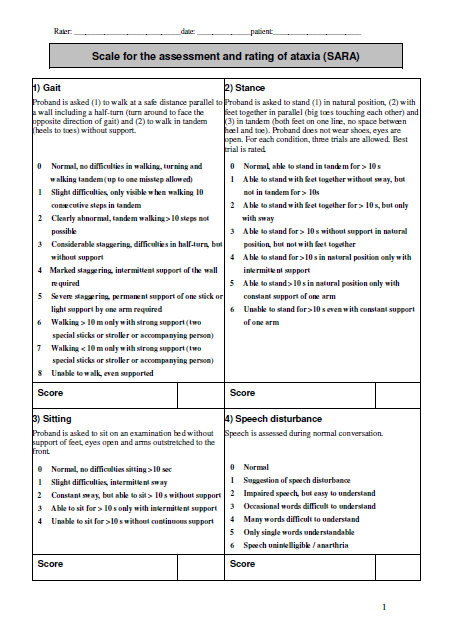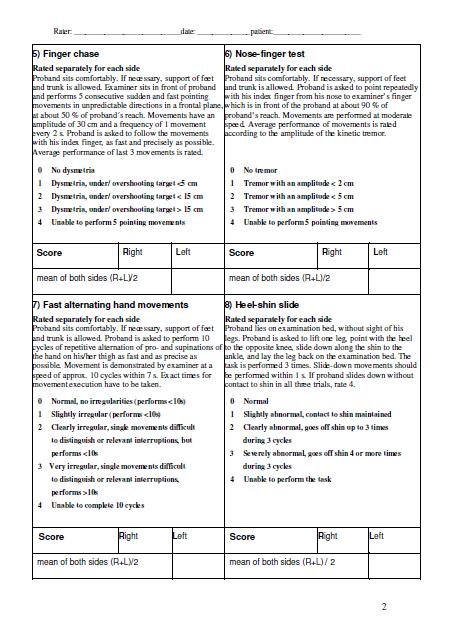Scale for the Assessment and Rating of Ataxia (SARA): Difference between revisions
No edit summary |
Kate Sampson (talk | contribs) No edit summary |
||
| Line 2: | Line 2: | ||
'''Original Editor '''- [[User:Ajay Upadhyay|Ajay Upadhyay]] | '''Original Editor '''- [[User:Ajay Upadhyay|Ajay Upadhyay]] | ||
'''Top Contributors''' - | '''Top Contributors''' - | ||
</div> | </div> | ||
== Objective<br> == | == Objective<br> == | ||
SARA is a clinical scale | SARA is a clinical scale developed by Schmitz-Hübsch et al which assesses a range of diffierent impairments in cerebellar ataxia. The scale is made up of 8 items related to gait, stance, sitting, speech, finger-chase test, nose-finger test, fast alternating movements and heel-shin test.<ref name="Weyer et al ">Weyer A, Abele M, Schmitz-Hubsch T, Schoch B, Frings M, Timmann D. Reliability And validity of the scale for the assessment and rating of ataxia: a study in 64 Ataxia patients. Movement Disorders 2007;22:1633–7</ref> Schmitz-Hübsch et al developed the Scale for the Assessment and Rating of Ataxia (SARA) as an alternative to The International Cooperative Ataxia Rating Scale (ICARS). The daily use of ICARS scale in ataxic patients is difficult due to its many assessment items.<ref>Trouillas P, Takayanagi T, Hallett M, Currier RD, Subramony SH, Wessel K, Bryer A, Diener HC, Massaquoi S, Gomez CM, et al. The Ataxia Neuropharmacology Committee of the World Federation of Neurology. International Cooperative Ataxia Rating Scale for pharmacological assessment of the cerebellar syndrome. J Neurol Sci. 1997;145:205–211.</ref> This new assessment tool has fewer assessment items than the ICARS and therefore has the advantage of easier daily assessment of ataxia. <ref>Schmitz-Hübsch T, du Montcel ST, Baliko L, Berciano J, Boesch S, Depondt C, Giunti P, Globas C, Infante J, Kang JS, et al. Scale for the assessment and rating of ataxia: development of a new clinical scale. Neurology. 2006;66:1717–1720.</ref> | ||
== Intended Population<br> == | == Intended Population<br> == | ||
| Line 21: | Line 20: | ||
[[Image:SARA.png|center]] | [[Image:SARA.png|center]] | ||
[[Image:SARA Pg. 2..png|center]] | [[Image:SARA Pg. 2..png|center]] | ||
== Reference<br> == | == Reference<br> == | ||
Schmitz-Hübsch T, Tezenas du Montcel S, Baliko L, Berciano J, Boesch S et al. Scale for the assessment and rating of ataxia: development of a new clinical scale. Neurology 2006;66:1717-1720. | Schmitz-Hübsch T, Tezenas du Montcel S, Baliko L, Berciano J, Boesch S et al. Scale for the assessment and rating of ataxia: development of a new clinical scale. Neurology 2006;66:1717-1720. | ||
Schmitz-Hübsch T, Fimmers R, Rakowicz M, Rola R, Zdzienicka E, Fancellu R et al. Responsiveness of different rating instruments in spinocerebellar ataxia patients. Neurology 2010;74:678-84 | Schmitz-Hübsch T, Fimmers R, Rakowicz M, Rola R, Zdzienicka E, Fancellu R et al. Responsiveness of different rating instruments in spinocerebellar ataxia patients. Neurology 2010;74:678-84 | ||
Weyer A, Abele M, Schmitz-Hübsch T, Schoch B, Frings M et al. Reliability and validity of the Scale for the Assessment and Rating of Ataxia: A Study in 64 ataxia patients. Mov Disord 2007;22:1633-1637. | Weyer A, Abele M, Schmitz-Hübsch T, Schoch B, Frings M et al. Reliability and validity of the Scale for the Assessment and Rating of Ataxia: A Study in 64 ataxia patients. Mov Disord 2007;22:1633-1637. | ||
== Evidence == | == Evidence == | ||
High inter-rater reliability (ICCs5 0.90–0.96) | High inter-rater reliability (ICCs5 0.90–0.96) | ||
High test–re-test reliability (ICCs5 0.90–0.96) | High test–re-test reliability (ICCs5 0.90–0.96) | ||
High internal consistency (Cronbach’s a50.94) | High internal consistency (Cronbach’s a50.94) | ||
Good internal structural validity | Good internal structural validity | ||
== Links == | == Links == | ||
| Line 47: | Line 46: | ||
<rss>http://www.ncbi.nlm.nih.gov/entrez/eutils/erss.cgi?rss_guid=1JiS13ehHQEsQrBXatRfBPZbFPCGb6TWfKUmIQOwgpkq5zwwhf|charset=UTF-8|short|max=10</rss> | <rss>http://www.ncbi.nlm.nih.gov/entrez/eutils/erss.cgi?rss_guid=1JiS13ehHQEsQrBXatRfBPZbFPCGb6TWfKUmIQOwgpkq5zwwhf|charset=UTF-8|short|max=10</rss> | ||
</div> | </div> | ||
== References == | == References == | ||
Revision as of 21:22, 23 February 2016
Original Editor - Ajay Upadhyay
Top Contributors -
Objective
[edit | edit source]
SARA is a clinical scale developed by Schmitz-Hübsch et al which assesses a range of diffierent impairments in cerebellar ataxia. The scale is made up of 8 items related to gait, stance, sitting, speech, finger-chase test, nose-finger test, fast alternating movements and heel-shin test.[1] Schmitz-Hübsch et al developed the Scale for the Assessment and Rating of Ataxia (SARA) as an alternative to The International Cooperative Ataxia Rating Scale (ICARS). The daily use of ICARS scale in ataxic patients is difficult due to its many assessment items.[2] This new assessment tool has fewer assessment items than the ICARS and therefore has the advantage of easier daily assessment of ataxia. [3]
Intended Population
[edit | edit source]
Clients with Ataxia
Method of Use[edit | edit source]
The SARA, which Schmitz-Hubsch presented in 2004, is a tool for assessing ataxia. It has eight items with total scores ranging from 0 (no ataxia) to 40 (most severe ataxia). Scores for the eight items range as follows: no ataxia, 1: gait (0-8 points), 2: stance (0-6 points), 3: sitting (0-4 points), 4: speech disturbance (0-6 points), 5: finger chase (0-4 points), 6: nose-finger test (0-4 points), 7: fast alternating hand movement (0-4 points), 8: heel-shin slide (0-4 points), and 40: severe ataxia. For motor activities of the four extremities (items 5-8), assessments are performed bilaterally, and the mean values are used to obtain the total score. Although the cerebellum is directly involved in the coordination of eye movements, oculomotor functions are not considered, as the validation trials indicated that they are determined by other factors than appendicular and midline ataxia.
Reference
[edit | edit source]
Schmitz-Hübsch T, Tezenas du Montcel S, Baliko L, Berciano J, Boesch S et al. Scale for the assessment and rating of ataxia: development of a new clinical scale. Neurology 2006;66:1717-1720.
Schmitz-Hübsch T, Fimmers R, Rakowicz M, Rola R, Zdzienicka E, Fancellu R et al. Responsiveness of different rating instruments in spinocerebellar ataxia patients. Neurology 2010;74:678-84
Weyer A, Abele M, Schmitz-Hübsch T, Schoch B, Frings M et al. Reliability and validity of the Scale for the Assessment and Rating of Ataxia: A Study in 64 ataxia patients. Mov Disord 2007;22:1633-1637.
Evidence[edit | edit source]
High inter-rater reliability (ICCs5 0.90–0.96)
High test–re-test reliability (ICCs5 0.90–0.96)
High internal consistency (Cronbach’s a50.94)
Good internal structural validity
Links[edit | edit source]
Recent Related Research (from Pubmed)[edit | edit source]
Failed to load RSS feed from http://www.ncbi.nlm.nih.gov/entrez/eutils/erss.cgi?rss_guid=1JiS13ehHQEsQrBXatRfBPZbFPCGb6TWfKUmIQOwgpkq5zwwhf|charset=UTF-8|short|max=10: Error parsing XML for RSS
References[edit | edit source]
References will automatically be added here, see adding references tutorial.
- ↑ Weyer A, Abele M, Schmitz-Hubsch T, Schoch B, Frings M, Timmann D. Reliability And validity of the scale for the assessment and rating of ataxia: a study in 64 Ataxia patients. Movement Disorders 2007;22:1633–7
- ↑ Trouillas P, Takayanagi T, Hallett M, Currier RD, Subramony SH, Wessel K, Bryer A, Diener HC, Massaquoi S, Gomez CM, et al. The Ataxia Neuropharmacology Committee of the World Federation of Neurology. International Cooperative Ataxia Rating Scale for pharmacological assessment of the cerebellar syndrome. J Neurol Sci. 1997;145:205–211.
- ↑ Schmitz-Hübsch T, du Montcel ST, Baliko L, Berciano J, Boesch S, Depondt C, Giunti P, Globas C, Infante J, Kang JS, et al. Scale for the assessment and rating of ataxia: development of a new clinical scale. Neurology. 2006;66:1717–1720.








